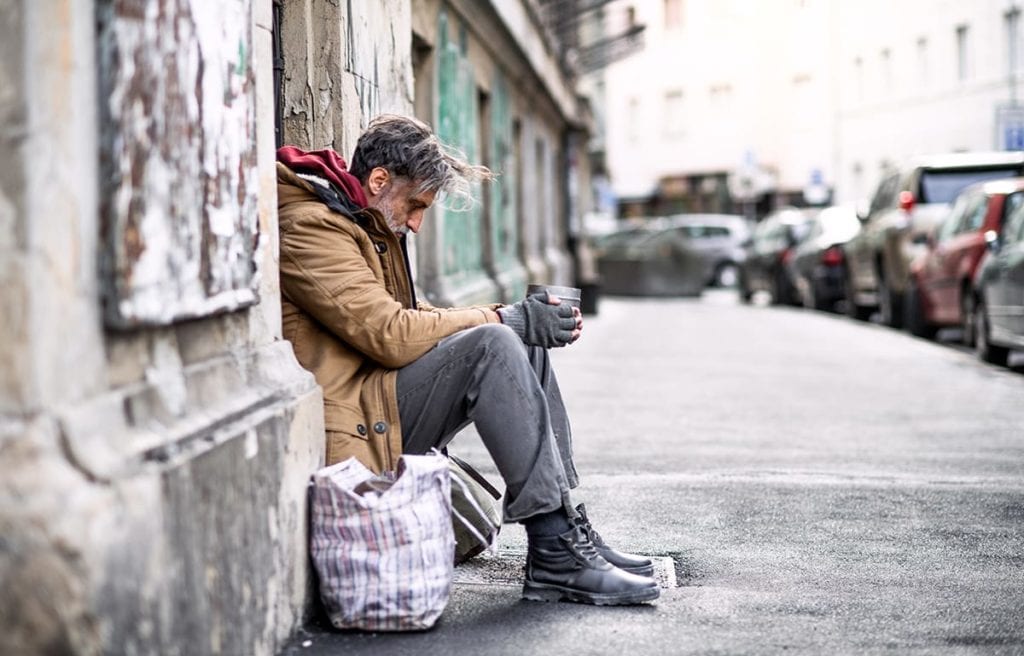Homelessness and substance abuse often go hand in hand, likely because some addictions are so overpowering they lead the alcohol or drug user to chase their next high at the cost of nearly everything else in their lives — their health, job, family and home. Sadly the rate of heroin abuse among the homeless is troublesome.
Addiction and mental illness are two primary factors that lead to financial instability and the loss of permanent housing, says the National Coalition for the Homeless (NCH). These co-occurring issues can make it difficult to maintain employment and housing, and also can lead to family disputes where the addict is not welcome in a family member’s home.
Mental Illness, Substance Abuse and Homelessness
It is estimated that about one in four homeless people in the U.S. suffers from a mental illness, and about one in three suffers from substance abuse. Heroin is an opiate that is so addictive and dangerous that in order to kick a heroin habit, an addict needs ready access to a rehab center where medically supervised heroin detox is provided, followed by a structured rehabilitation program. Unfortunately, many homeless people with heroin addiction don’t find their way to drug rehab or heroin detox.
Addiction Treatment and Health Services for Homeless People
Most homeless people will require mental health services and substance abuse treatment if they are to regain the health and stability they need to rise out of poverty and be productive in society. For those with addictions, formal addiction treatment involving detox and rehab is critical, which can be costly and challenging to coordinate. Collaborative help is needed from volunteer groups, charitable organizations, churches, government agencies and outreach programs working together to connect homeless individuals with the services they need. Homeless people who use heroin will need to be guided to rehab centers that can safely provide heroin detox and addiction treatment.
Medical detoxification — which is always the first step to take before addressing the addiction and its underlying causes—allows the addict’s body to get rid of the heroin that is in the system, while managing the symptoms of withdrawal. Symptoms of withdrawal from heroin are considered severe and difficult to manage, and can include muscle and bone pain, diarrhea, vomiting, uncontrollable let movements, cold flashes, sleep problems and intense craving for the drug. If the drug’s chemicals remain in the body, the heroin addict will continue to crave the drug and experience withdrawal symptoms, which will lead to relapse and make recovery impossible.
Heroin Detox and Addiction Rehabilitation
Some heroin users will overdose on the drug and wind up in the emergency room where they are given a medicine called naloxone, which can treat the overdose and save the person’s life if given immediately. These patients are sometimes transferred directly to another facility to undergo medically assisted heroin detox. Heroin detox, followed by addiction rehabilitation that should last long enough to effect significant change and provide a solid foundation for recovery (at least 30 days, and ideally 60-90 days), typically involves several steps:
- Step 1: Detox — A few different medications are used for heroin detox, including buprenorphine, methadone, and naltrexone. These medications bind to the same opioid receptors in the brain that heroin does, but not as intensely, and help reduce cravings and withdrawal symptoms while the person abstains from using heroin.
- Step 2: Medical Treatment of Other Illnesses — Upon entering a heroin detox and rehab facility, patients will typically be tested for other potential illnesses stemming from shared needle use, including HIV/AIDS, hepatitis B and C, tuberculosis, and other infectious diseases. Patients will also be evaluated and treated for other addictions.
- Step 3: Counseling and Evaluation — After a few days of detox, the patient has usually stabilized enough to enter the next step in treatment. This involves being counseled, evaluated and treated for co-occurring mental health issues such as depression and anxiety.
- Step 4: Addiction Rehabilitation — The patient transitions into the addiction rehabilitation program, though they may continue taking their detox medication in a tapering dose. They will continue taking medication for any other health issues, as well as for any co-occurring mental health disorders as they progress through counseling and also begin behavioral therapies. Rehabilitation generally includes group support and individual sessions that utilize a range of behavioral therapies, including cognitive behavioral therapy (CBT). CBT helps an addict understand their addictive thought processes and manage their drug-use behaviors. They will learn how to use healthier ways to deal with stress and the people, places and things that trigger them to want to use again.
Aftercare and Sober Recovery
For addicts in recovery who are not homeless, once they have completed formal addiction treatment, they can transition into a sober living environment or return home to continue their sobriety independently by following their addiction recovery aftercare plan, including participation in self-help sober support groups. For addicts in recovery who are homeless, successful recovery will require additional support that connects them with resources for food and safe shelter, as well as assistance in finding job training or work re-entry programs, and leads for long-term housing and support.
Learn More About Heroin Abuse Among the Homeless Today
At Promises Behavioral Health, we know that addiction can lead to terrible consequences. If you need help with addiction, contact us today at 844.875.5609. We provide treatment for many addictions, including:
To learn more about heroin abuse among the homeless, or to enroll in a treatment program, call Promises today.

